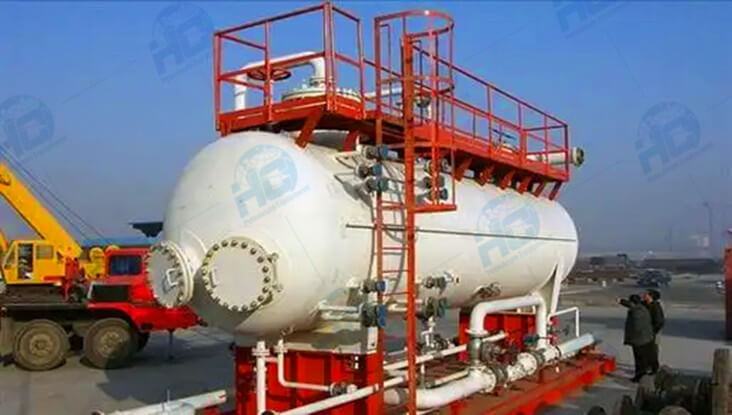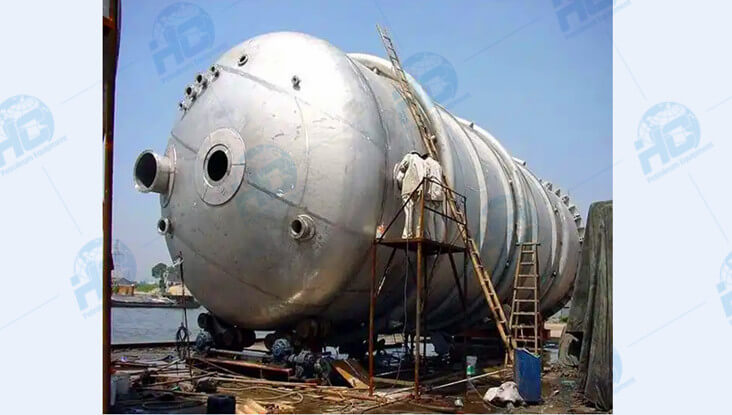Types of Oil and Gas Separators Used in Offshore Drilling
Offshore drilling operations demand efficient equipment to separate hydrocarbons and other well fluids to ensure smooth production and safety. Oil and gas separators play a critical role in managing these processes by isolating oil, gas, and water for further treatment or transportation. Today, HC's engineers introduce several commonly used types of separators, hoping to assist users in making the right selection.
1. Horizontal Three-Phase Separators
Horizontal three-phase separators are a popular choice in offshore drilling due to their ability to handle large volumes of well fluid while maintaining a compact footprint. These separators leverage gravity to separate oil, water, and gas based on their density differences.
Advantages: High processing capacity, ease of operation, and stability in separating emulsions.
Applications: Often deployed on platforms where space is limited and production rates are high.
Special Considerations: Requires robust construction to withstand the corrosive marine environment.

2. Vertical Two-Phase Separators
Vertical separators are favored for installations where horizontal space is constrained but vertical height is available. These are particularly efficient for separating gas from liquids.
Advantages: Minimal footprint, effective handling of slugs and foamy liquids.
Applications: Suitable for high-pressure wells or wells with fluctuating flow conditions.
Special Considerations: Periodic maintenance is needed to avoid sand buildup in the bottom section.
3. Spherical Separators
Spherical separators are compact and versatile, making them suitable for specific offshore applications. Their spherical shape enhances pressure resistance and reduces structural stresses.
Advantages: Lightweight, easy to transport, and handles high-pressure scenarios effectively.
Applications: Commonly used during testing phases or as part of temporary setups.
Special Considerations: Limited capacity for handling large volumes of liquids.

4. Scrubber-Type Separators
Designed primarily for gas-heavy production streams, scrubber-type separators focus on capturing liquid droplets from the gas phase to improve processing efficiency.
Advantages: Excellent gas-liquid separation and minimal liquid loss.
Applications: Frequently used in natural gas processing where clean gas streams are required.
Special Considerations: Proper design and operation are critical to prevent liquid carryover.
5. Compact Multiphase Separators
As offshore operations become more advanced, compact multiphase separators are gaining prominence. These separators integrate mechanical, thermal, and chemical processes for efficient separation within a reduced footprint.
Advantages: Space-saving design, adaptability to varying flow conditions, and high operational efficiency.
Applications: Ideal for offshore facilities with space and weight limitations, including subsea installations.
Special Considerations: Higher cost and complex maintenance requirements compared to conventional separators.

Key Considerations for Offshore Separator Selection
Choosing the right separator type for offshore drilling involves evaluating various factors:
Fluid Composition: The proportion of oil, gas, water, and solids in the well stream determines the separator design.
Space and Weight Limitations: Offshore platforms require compact equipment to maximize available space.
Environmental Resistance: Materials must withstand corrosion, high pressure, and fluctuating temperatures.
Operational Versatility: Flexibility to handle variations in flow rate and pressure ensures consistent performance.
The diverse range of oil and gas separators used in offshore drilling highlights the importance of selecting equipment that aligns with operational needs and environmental challenges. From horizontal three-phase separators to compact multiphase designs, each type has specific strengths that contribute to efficient resource processing.
By understanding these separator types and their applications, operators can make informed decisions that enhance productivity while ensuring safety and compliance with environmental standards.
